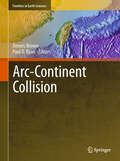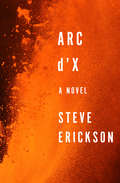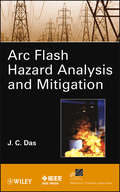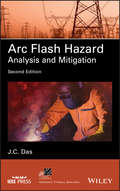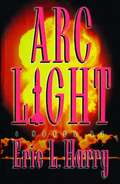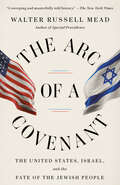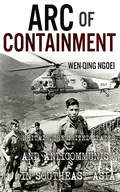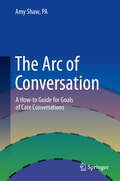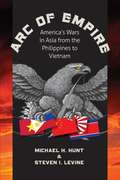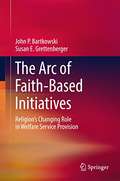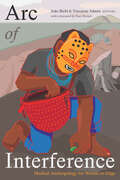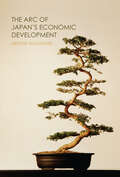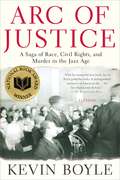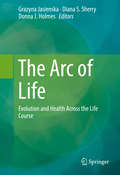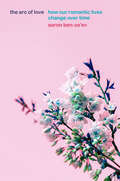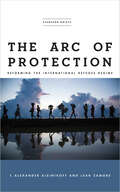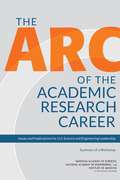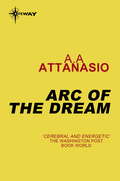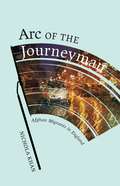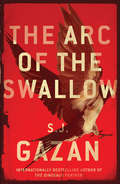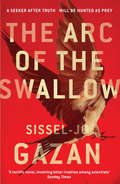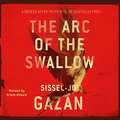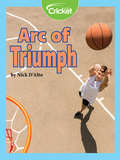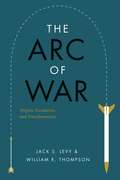- Table View
- List View
Arc-Continent Collision (Frontiers in Earth Sciences)
by Dennis Brown Paul D. RyanArc-continent collision has been one of the important tectonic processes in the formation of mountain belts throughout geological time, and it continues to be so today along tectonically active plate boundaries such as those in the SW Pacific or the Caribbean. Arc-continent collision is thought to have been one of the most important process involved in the growth of the continental crust over geological time, and may also play an important role in its recycling back into the mantle via subduction. Understanding the geological processes that take place during arc-continent collision is therefore of importance for our understanding of how collisional orogens evolve and how the continental crust grows or is destroyed. Furthermore, zones of arc-continent collision are producers of much of the worlds primary economic wealth in the form of minerals, so understanding the processes that take place during these tectonic events is of importance in modeling how this mineral wealth is formed and preserved. This book brings together seventeen papers that are dedicated to the investigation of the tectonic processes that take place during arc-continent collision. It is divided into four sections that deal firstly with the main players involved in any arc-continent collision; the continental margin, the subduction zone, and finally the volcanic arc and its mineral deposits. The second section presents eight examples of arc-continent collisions that range from being currently active through to Palaeoproterozoic in age. The third section contains two papers, one that deals with the obduction of large-slab ophiolites and a second that presents a wide range of physical models of arc-continent collision. The fourth section brings everything that comes before together into a discussion of the processes of arc-continent collision.
Arc d'X: A Novel
by Steve EricksonIn a desperate effort to liberate herself, a fourteen-year-old slave—mistress to the man who invented America—finds herself flung into a different time and worldSteve Erickson&’s provocative reimagining of American history, Arc d&’X begins with the relationship between Thomas Jefferson and Sally Hemings. With &“skin . . . too white to be quite black and too black to be quite white,&” Sally is loved only to the extent that she can be possessed, and finds hope only in the promise that her children&’s lives will be different from her own. The couple&’s paradox-riven union echoes through the ages and in an alternate epoch where time plays by other rules. In Aeonopolis, a theocratic city at the foot of a volcano, priests seek to have Sally indicted, and in an emptied-out Berlin, the Wall is being rebuilt. Dizzyingly imaginative, Arc d&’X is an unrivaled exploration of &“the pursuit of happiness.&”
ARC Flash Hazard Analysis and Mitigation (IEEE Press Series on Power Engineering #91)
by J. C. DasUp-to-date analysis methodologies and practical mitigation for a major electrical safety concern Arc Flash Hazard Analysis and Mitigation is the first book to focus specifically on arc flash hazards and provide the latest methodologies for its analysis as well as practical mitigation techniques. Consisting of sixteen chapters, this fully up-to-date handbook covers all aspects of arc flash hazard calculations and mitigation. It addresses the calculations of short circuits, protective relaying, and varied electrical systems configurations in electrical power systems. It also examines protection systems, including differential relays, arc flash sensing relays, protective relaying coordination, current transformer operation and saturation, and applications to major electrical equipment from the arc flash point of view. Current technologies and strategies for arc flash mitigation are explored. Using the methodology, analysis, and preventive measures discussed in the book, the arc flash hazard incident energy can be reduced to 8 cal/cm2 or less for the new and existing electrical distribution systems. This powerful resource: Features the most up-to-date arc flash analysis methodologies Presents arc flash hazard calculations in dc systems Supplies practical examples and case studies Provides end-of-chapter reviews and questions Includes a Foreword written by Lanny Floyd, a world-renowned leader in electrical safety who is DuPont's Principal Consultant on Electrical Safety and Technology Arc Flash Hazard Analysis and Mitigation is a must-have guide for electrical engineers engaged in design, operation, and maintenance, consulting engineers, facility managers, and safety professionals.
Arc Flash Hazard Analysis and Mitigation (IEEE Press Series on Power and Energy Systems #91)
by J. C. DasThis new edition of the definitive arc flash reference guide, fully updated to align with the IEEE's updated hazard calculations An arc flash, an electrical breakdown of the resistance of air resulting in an electric arc, can cause substantial damage, fire, injury, or loss of life. Professionals involved in the design, operation, or maintenance of electric power systems require thorough and up-to-date knowledge of arc flash safety and prevention methods. Arc Flash Hazard Analysis and Mitigation is the most comprehensive reference guide available on all aspects of arc flash hazard calculations, protective current technologies, and worker safety in electrical environments. Detailed chapters cover protective relaying, unit protection systems, arc-resistant equipment, arc flash analyses in DC systems, and many more critical topics. Now in its second edition, this industry-standard resource contains fully revised material throughout, including a new chapter on calculation procedures conforming to the latest IEEE Guide 1584. Updated methodology and equations are complemented by new practical examples and case studies. Expanded topics include risk assessment, electrode configuration, the impact of system grounding, electrical safety in workplaces, and short-circuit currents. Written by a leading authority with more than three decades' experience conducting power system analyses, this invaluable guide: Provides the latest methodologies for flash arc hazard analysis as well practical mitigation techniques, fully aligned with the updated IEEE Guide for Performing Arc-Flash Hazard Calculations Explores an inclusive range of current technologies and strategies for arc flash mitigation Covers calculations of short-circuits, protective relaying, and varied electrical system configurations in industrial power systems Addresses differential relays, arc flash sensing relays, protective relaying coordination, current transformer operation and saturation, and more Includes review questions and references at the end of each chapter Part of the market-leading IEEE Series on Power Engineering, the second edition of Arc Flash Hazard Analysis and Mitigation remains essential reading for all electrical engineers and consulting engineers.
Arc Light
by Eric HarryIn a scenario terrifyingly close to today's headlines, Harry's debut novel opens with a North Korean invasion of South Korea that leads, through a series of tragic errors and decisions, to a Russian nuclear attack on military bases in the US. Like techno-thriller master Tom Clancy, Harry offers a sprawling narrative that focuses on a small army of soldiers, politicians, and their families, American and Russian. National Security Advisor Greg Lambert must keep and tell secrets that may lead to Armageddon; Reservist David Chandler must leave his pregnant wife in order to drive a tank; US President Walter Livingston, eager for peace, must endure the ignominy of impeachment; Russian General Yuri Razov must deal with the consequences of his initial decision to launch nuclear missiles. Ground, air, and submarine battles alternate with scenes of anarchy stateside as exhausted leaders are forced to make instant decisions that might snuff out humanity forever. With a masterful grasp of military strategy and geopolitics, Harry moves his characters through nightmares of blood and death; his intricately detailed scenes of nuclear devastation are particularly horrifying. Told through a series of rapid-fire climaxes, this novel, a political and military cautionary tale of considerable power and conviction, will keep readers riveted.
The Arc of a Covenant: The United States, Israel, and the Fate of the Jewish People
by Walter MeadA NEW YORK TIMES BEST BOOK OF THE YEAR • A groundbreaking work that overturns the conventional understanding of the Israeli-American relationship and, in doing so, explores how fundamental debates about American identity drive our country's foreign policy.In this bold examination of the Israeli-American relationship, Walter Russell Mead demolishes the myths that both pro-Zionists and anti-Zionists have fostered over the years. He makes clear that Zionism has always been a divisive subject in the American Jewish community, and that American Christians have often been the most fervent supporters of a Jewish state, citing examples from the time of J.P. Morgan and John D. Rockefeller to the present day.He spotlights the almost forgotten story of left-wing support for Zionism, arguing that Eleanor Roosevelt and liberal New Dealers had more influence on President Truman's Israel policy than the American Jewish community--and that Stalin's influence was more decisive than Truman's in Israel's struggle for independence. Mead shows how Israel's rise in the Middle East helped kindle both the modern evangelical movement and the Sunbelt coalition that carried Reagan into the White House. Highlighting the real sources of Israel's support across the American political spectrum, he debunks the legend of the so-called "Israel lobby." And, he describes the aspects of American culture that make it hostile to anti-Semitism and warns about the danger to that tradition of tolerance as our current culture wars heat up.With original analysis and in lively prose, Mead illuminates the American-Israeli relationship, how it affects contemporary politics, and how it will influence the future of both that relationship and American life.
Arc of Containment: Britain, the United States, and Anticommunism in Southeast Asia (The United States in the World)
by Wen-Qing NgoeiArc of Containment recasts the history of American empire in Southeast and East Asia from World War II through the end of American intervention in Vietnam. Setting aside the classic story of anxiety about falling dominoes, Wen-Qing Ngoei articulates a new regional history premised on strong security and sure containment guaranteed by Anglo-American cooperation.Ngoei argues that anticommunist nationalism in Southeast Asia intersected with preexisting local antipathy toward China and the Chinese diaspora to usher the region from European-dominated colonialism to US hegemony. Central to this revisionary strategic assessment is the place of British power and the effects of direct neocolonial military might and less overt cultural influences based in decades of colonial rule. Also essential to the analysis in Arc of Containment is the considerable influence of Southeast Asian actors upon Anglo-American imperial strategy throughout the post-war period. In Arc of Containment Ngoei shows how the pro-US trajectory of Southeast Asia after the Pacific War was, in fact, far more characteristic of the wider region's history than American policy failure in Vietnam. Indeed, by the early 1970s, five key anticommunist nations—Malaya, Singapore, Philippines, Thailand, and Indonesia—had quashed Chinese-influenced socialist movements at home and established, with U.S. support, a geostrategic arc of states that contained the Vietnamese revolution and encircled China. In the process, the Euro-American colonial order of Southeast Asia passed from an era of Anglo-American predominance into a condition of US hegemony. Arc of Containment demonstrates that American failure in Vietnam had less long-term consequences than widely believed because British pro-West nationalism had been firmly entrenched twenty-plus years earlier. In effect, Ngoei argues, the Cold War in Southeast Asia was but one violent chapter in the continuous history of western imperialism in the region in the twentieth century.
The Arc of Conversation: A How-to Guide for Goals of Care Conversations
by Amy Shaw, PAIntending to fill an important gap in medical training, this book presents an easy-to-learn, standardized approach to having compassionate and collaborative goals of care conversations with patients and families, a skill that can be difficult for clinicians to learn and that is not part of standard medical education curricula. Developed by a Palliative Care provider, this is the first book to teach everything clinicians need to know to gently guide patients and families through what can often be difficult discussions about illness, disease, end-of-life wishes, and hospice care. This technique can be used to discuss any medical diagnosis or treatment, be employed at any age or stage of an illness, and can be used by health care professionals at any level. Readers will be introduced to the patterns of decline patients follow toward the end of life, criteria for recognizing when a patient’s time is limited, hospice care, ground rules for compassionate communication, and a step-wise method of leading patients and families through difficult goals of care conversations in a collaborative way. The book includes specific questions to ask and starter language clinicians can use for developing their own patient-friendly talking points about disease progression, the end of life, concerns that a patient’s time is limited, advanced directives, code status, and hospice care. An Arc of Conversation Guide, for use when learning this technique, is also included. While modern medicine is terrific at acute stabilization of illness or injury, it often ignores the elephant in the room—disease progression and death. By doing so, the healthcare system frequently misses opportunities to align patient wishes with the care they receive. Furthermore, physicians often avoid difficult conversations with patients due to a lack of training or the assumption that hospice care represents medical or personal failure. Incorporating the material and technique taught in The Arc of Conversation into everyday practice will enable clinicians to acknowledge and discuss patient decline and to confidently include hospice care as a viable option for treatment that can support patient values, wishes, and priorities. Moving toward a continually collaborative approach with patients—a shift away from physician-directed care to patient-centered care—will enable clinicians to develop treatment plans that prioritize outcomes that matter most to patients and families, improving patient and family experience of health care across their lives and providing patients with the ‘soft landing’ they want at the end.
Arc of Empire
by Michael H. Hunt Steven I. LevineAlthough conventionally treated as separate, America's four wars in Asia were actually phases in a sustained U.S. bid for regional dominance, according to Michael H. Hunt and Steven I. Levine. This effort unfolded as an imperial project in which military power and the imposition of America's political will were crucial. Devoting equal attention to Asian and American perspectives, the authors follow the long arc of conflict across seventy-five years from the Philippines through Japan and Korea to Vietnam, tracing along the way American ambition, ascendance, and ultimate defeat. They show how these wars are etched deeply in eastern Asia's politics and culture.The authors encourage readers to confront the imperial pattern in U.S. history with implications for today's Middle Eastern conflicts. They also offer a deeper understanding of China's rise and Asia's place in today's world.For instructors: An Online Instructor's Manual is available, with teaching tips for using Arc of Empire in graduate and undergraduate courses on America's wars in Asia. It includes lecture topics, chronologies, and sample discussion questions.
The Arc of Faith-Based Initiatives: Religion's Changing Role In Welfare Service Provision
by John P. Bartkowski Susan E. GrettenbergerAnalyzes the activities of faith-based organizations in Mississippi, Michigan, and the Pacific Northwest.<p><p> Compares services delivered by faith-based organizations and secular agencies.<p> Examines family support, transitional homeless, and addiction recovery programs.<p> Offers an in-depth analysis of the topic with rich qualitative data.<p>This volume offers an in-depth examination of a diverse range of faith-based programs implemented in three different geographical locales: family support in rural Mississippi, transitional housing in Michigan, and addiction recovery in the Pacific Northwest (Washington-Oregon). Various types of religious service providers—faith-intensive and faith-related—are carefully examined, and secular organizations also serve as an illuminating point of comparison. Among other insights, this book reveals how the “three C’s” of social service provision—programmatic content, organizational culture, and ecological context—all combine to shape the delivery of welfare services in the nonprofit world. This book warns against simplistic generalizations about faith-based organizations. Faith-based providers exhibit considerable diversity and, quite often, remarkable resilience in the face of challenging social circumstances. An appreciation of these nuances is critical as policies concerning faith-based organizations continue to evolve.
Arc of Interference: Medical Anthropology for Worlds on Edge (Critical Global Health: Evidence, Efficacy, Ethnography)
by João Biehl and Vincanne AdamsThe radically humanistic essays in Arc of Interference refigure our sense of the real, the ethical, and the political in the face of mounting social and planetary upheavals. Creatively assembled around Arthur Kleinman’s medical anthropological arc and eschewing hegemonic modes of intervention, the essays advance the notion of a care-ful ethnographic praxis of interference. To interfere is to dislodge ideals of naturalness, blast enduring binaries (human/nonhuman, self/other, us/them), and redirect technocratic agendas while summoning relational knowledge and the will to create community. The book’s multiple ethnographic arcs of interference provide a vital conceptual toolkit for today’s world and a badly needed moral perch from which to peer toward just horizons.Contributors. Vincanne Adams, João Biehl, Davíd Carrasco, Lawrence Cohen, Jean Comaroff, Robert Desjarlais, Paul Farmer, Marcia Inhorn, Janis H. Jenkins, David S. Jones, Salmaan Keshavjee, Arthur Kleinman, Margaret Lock, Adriana Petryna
The Arc of Japan's Economic Development
by Arthur AlexanderThis core textbook is the definitive overview of the Japanese economy. It charts its history from the period before the Meiji restoration and its astonishing growth throughout the twentieth century before conducting a thorough analysis of the contemporary scene and the implications of the ongoing financial crisis. Written by a leading authority in the field, this is the only book to include substantive material on post-crisis Japan and it includes key material on international trade and foreign direct investment. Timely and topical, it gives a clear overview of the Japanese economy.
Arc of Justice: A Saga of Race, Civil Rights, and Murder in the Jazz Age
by Kevin BoyleAn electrifying story of the sensational murder trial that divided a city and ignited the civil rights struggle<P><P> In 1925, Detroit was a smoky swirl of jazz and speakeasies, assembly lines and fistfights. The advent of automobiles had brought workers from around the globe to compete for manufacturing jobs, and tensions often flared with the KKK in ascendance and violence rising. Ossian Sweet, a proud Negro doctor-grandson of a slave-had made the long climb from the ghetto to a home of his own in a previously all-white neighborhood. Yet just after his arrival, a mob gathered outside his house; suddenly, shots rang out: Sweet, or one of his defenders, had accidentally killed one of the whites threatening their lives and homes. <P> And so it began-a chain of events that brought America's greatest attorney, Clarence Darrow, into the fray and transformed Sweet into a controversial symbol of equality. Historian Kevin Boyle weaves the police investigation and courtroom drama of Sweet's murder trial into an unforgettable tapestry of narrative history that documents the volatile America of the 1920s and movingly re-creates the Sweet family's journey from slavery through the Great Migration to the middle class. Ossian Sweet's story, so richly and poignantly captured here, is an epic tale of one man trapped by the battles of his era's changing times.<P> Arc of Justice is the winner of the 2004 National Book Award for Nonfiction.<P>
The Arc of Life
by Grazyna Jasienska Diana S. Sherry Donna J. HolmesGiven the rapidly developing area of evolutionary medicine and public health, The Arc of Life examines ways in which research conducted by biological anthropologists can enrich our understanding of variation in human health outcomes. The book aims not only to showcase the perspective that biological anthropologists bring to the burgeoning field of evolutionary medicine, but to underscore the context of human life history -- especially the concept of evolutionary trade-offs and the ensuing biological processes that can affect health status over the life course. This dual emphasis on life history theory and life cycle biology will make for a valuable and unique, yet complementary, addition to books already available on the subject of evolution and health. The book consolidates diverse lines of research within the field of biological anthropology, stimulates new directions for future research, and facilitates communication between subdisciplines of human biology operating at the forefront of evolutionary medicine.
The Arc of Love: How Our Romantic Lives Change Over Time
by Aaron Ben-Ze'evIs love best when it is fresh? For many, the answer is a resounding “yes.” The intense experiences that characterize new love are impossible to replicate, leading to wistful reflection and even a repeated pursuit of such ecstatic beginnings. Aaron Ben-Ze’ev takes these experiences seriously, but he’s also here to remind us of the benefits of profound love—an emotion that can only develop with time. In The Arc of Love, he provides an in-depth, philosophical account of the experiences that arise in early, intense love—sexual passion, novelty, change—as well as the benefits of cultivating long-term, profound love—stability, development, calmness. Ben-Ze’ev analyzes the core of emotions many experience in early love and the challenges they encounter, and he offers pointers for weathering these challenges. Deploying the rigorous analysis of a philosopher, but writing clearly and in an often humorous style with an eye to lived experience, he takes on topics like compromise, commitment, polyamory, choosing a partner, online dating, and when to say “I love you.” Ultimately, Ben-Ze’ev assures us, while love is indeed best when fresh, if we tend to it carefully, it can become more delicious and nourishing even as time marches on.
The Arc of Protection: Reforming the International Refugee Regime
by T. Alexander Aleinikoff Leah ZamoreThe international refugee regime is fundamentally broken. Designed in the wake of World War II to provide protection and assistance, the system is unable to address the record numbers of persons displaced by conflict and violence today. States have put up fences and adopted policies to deny, deter, and detain asylum seekers. People recognized as refugees are routinely denied rights guaranteed by international law. The results are dismal for the millions of refugees around the world who are left with slender prospects to rebuild their lives or contribute to host communities. T. Alexander Aleinikoff and Leah Zamore lay bare the underlying global crisis of responsibility. The Arc of Protection adopts a revisionist and critical perspective that examines the original premises of the international refugee regime. Aleinikoff and Zamore identify compromises at the founding of the system that attempted to balance humanitarian ideals and sovereign control of their borders by states. This book offers a way out of the current international morass through refocusing on responsibility-sharing, seeing the humanitarian-development divide in a new light, and putting refugee rights front and center.
The Arc of the Academic Research Career
by Committee on Science, Engineering, and Public Policy Policy and Global Affairs Institute of Medicine National Academy Of Sciences National Academy of Engineering Beryl Lieff BenderlyAmerica's research universities have undergone striking change in recent decades, as have many aspects of the society that surrounds them. This change has important implications for the heart of every university: the faculty. To sustain their high level of intellectual excellence and their success in preparing young people for the various roles they will play in society, universities need to be aware of how evolving conditions affect their ability to attract the most qualified people and to maximize their effectiveness as teachers and researchers. Gender roles, family life, the demographic makeup of the nation and the faculty, and the economic stability of higher education all have shifted dramatically over the past generation. In addition, strong current trends in technology, funding, and demographics suggest that change will continue and perhaps even accelerate in academe in the years to come. One central element of academic life has remained essentially unchanged for generations, however: the formal structure of the professorial career. Developed in the mid-nineteenth and early twentieth centuries to suit circumstances quite different from today's, and based on traditions going back even earlier, this customary career path is now a source of strain for both the individuals pursuing it and the institutions where they work. The Arc of the Academic Research Career is the summary of a workshop convened by The Committee on Science, Engineering, and Public Policy in September 2013 to examine major points of strain in academic research careers from the point of view of both the faculty members and the institutions. National experts from a variety of disciplines and institutions discussed practices and strategies already in use on various campuses and identified issues as yet not effectively addressed. This workshop summary addresses the challenges universities face, from nurturing the talent of future faculty members to managing their progress through all the stages of their careers to finding the best use of their skills as their work winds down.
Arc of the Dream: Radix Tetrad: Book 3 (Radix)
by A.A. AttanasioEarth's last hope? The Arc, a being of immense power, trapped within a continuum too small, fights for its freedom. Its monumental struggle will touch a few select individuals on Earth - and in doing so, change their lives forever. The Arc may also be the last hope for humanity's survival.Author's Note: The volumes of this series can each be read independently of the others. The feature that unifies them is their individual observations of science fiction's sub-genre: "space opera," which the editors David G. Hartwell and Kathryn Cramer define as "colorful, dramatic, large-scale science fiction adventure, competently and sometimes beautifully written, usually focused on a sympathetic, heroic central character and plot action, and usually set in the relatively distant future, and in space or on other worlds, characteristically optimistic in tone. It often deals with war, piracy, military virtues, and very large-scale action, large stakes."
Arc of the Journeyman: Afghan Migrants in England (Muslim International #3)
by Nichola KhanA monumental account of one migrant community&’s everyday lives, struggles, and aspirations Forty years of continuous war and conflict have made Afghans the largest refugee group in the world. In this first full-scale ethnography of Afghan migrants in England, Nichola Khan examines the imprint of violence, displacement, kinship obligations, and mobility on the lives and work of Pashtun journeyman taxi drivers in Britain. Khan&’s analysis is centered in the county of Sussex, site of Brighton&’s orientalist Royal Pavilion and the former home of colonial propagandist Rudyard Kipling. Her nearly two decades of relationships and fieldwork have given Khan a deep understanding of the everyday lives of Afghan migrants, who face unrelenting pressures to remit money to their struggling relatives in Pakistan and Afghanistan, adhere to traditional values, and resettle the wives and children they have left behind. This kaleidoscopic narrative is enriched by the migrants&’ own stories and dreams, which take on extra significance among sleep-deprived taxi drivers. Khan chronicles the way these men rely on Pashto poems and aphorisms to make sense of what is strange or difficult to bear. She also attests to the pleasures of local family and friends who are less demanding than kin back home—sharing connection and moments of joy in dance, excursions, picnics, and humorous banter. Khan views these men&’s lives through the lenses of movement—the arrival of friends and family, return visits to Pakistan, driving customers, even the journey to remit money overseas—and immobility, describing the migrants who experience &“stuckness&” caused by unresponsive bureaucracies, chronic insecurity, or struggles with depression and other mental health conditions. Arc of the Journeyman is a deeply humane portrayal that expands and complicates current perceptions of Afghan migrants, offering a finely analyzed description of their lives and communities as a moving, contingent, and fully contemporary force.
The Arc of the Swallow
by S. J. GazanDanish author S.J. Gazan established herself as an international talent to watch with her debut thriller novel, The Dinosaur Feather. In addition to being named "Crime Novel of the Decade" by the Danish Broadcasting Corporation, NPR's Maureen Corrigan called it her favorite mystery of 2013, and The Wall Street Journal's Tom Nolan placed it in his year-end top ten list. Now, Gazan's much-anticipated follow-up is here, bringing back maverick policeman Soren Marhauge. In The Arc of the Swallow, a perilous investigation reveals a profit-motivated conspiracy involving the upper reaches of Big Pharma, government, and academia. Biology Ph.D. candidate Marie Skov is devastated when, on the same day as her mother's death, her mentor Kristian Storm apparently kills himself. Storm had been facing academic dishonesty charges, as well as heated criticism of his research on a vaccine for African children--that suggested the vaccine was causing more harm than it was preventing. Skov is skeptical that the death was a suicide. She knows Storm's research on the vaccine was sound, and learns that his on-site work in Guinea-Bissau was marred by intimidation, sabotaged data, and the suspicious death of another scientist. She also learns that in his final days, Storm felt he was being followed by a blue Ford with tinted windows. Soon afterwards, a blue Ford with tinted windows parks across from Skov's home. The police have no interest in re-examining the official narrative. But Marhauge shares Skov's desire for answers, and defies his superiors to help her investigate. They receive unlikely help from a Nobel Prize-winning rival of Storm's, and find themselves on a perilous trail that leads to Big Pharma and the World Health Organization. Interwoven in this thrilling storyline are deeply-moving portraits of Skov's troubled family and Marhauge's tenuous relationship with his girlfriend, another biologist. The result is a complex page-turner that establishes S.J. Gazan (herself a biologist) as a world-class author at the beginning of a formidable career.
The Arc of the Swallow
by Sissel-Jo GazanA seeker after truth will be hunted as prey. When controversial Professor Kristian Storm is found hanged in his office, his assistant Marie Skov refuses to believe that he has committed suicide. Having just returned from West Africa on a research trip, the late scientist had uncovered a shocking truth about immunology programmes in the developing world. Former police detective Søren Marhauge is determined to prove what really happened to the professor. While Marie grapples with Storm's disputed legacy, Søren leads them both beyond legal boundaries and behind the scenes of the cut-throat pharmaceutical industry. Sissel-Jo Gazan's bestselling and influential The Dinosaur Feather introduced Danish Crime lovers to the competitive and perfidious world of biological science. In this outstanding sequel, her ingenious research, complex characterisation and suspenseful plotting supercedes the promise of her internationally acclaimed breakthrough.
The Arc of the Swallow
by Sissel-Jo GazanA seeker after truth will be hunted as prey.When controversial Professor Kristian Storm is found hanged in his office, his assistant Marie Skov refuses to believe that he has committed suicide. Having just returned from West Africa on a research trip, the late scientist had uncovered a shocking truth about immunology programmes in the developing world. Former police detective Søren Marhauge is determined to prove what really happened to the professor. While Marie grapples with Storm's disputed legacy, Søren leads them both beyond legal boundaries and behind the scenes of the cut-throat pharmaceutical industry. Sissel-Jo Gazan's bestselling and influential The Dinosaur Feather introduced Danish Crime lovers to the competitive and perfidious world of biological science. In this outstanding sequel, her ingenious research, complex characterisation and suspenseful plotting supercedes the promise of her internationally acclaimed breakthrough.
The Arc of the Swallow
by Sissel-Jo GazanProfessor Kristian Storm worked tirelessly on vaccination programmes protecting children in West Africa. But shortly after his research hit upon a shocking discovery, Storm is found hanged in his office.His protégé Marie Skov refuses to believes it was suicide. But Storm's theories were controversial, and his critics powerful. Her only ally is Detective Søren Marhauge. Behind the scenes of the cut-throat pharmaceutical industry, Marie and Søren hunt for the truth. As they themselves come under threat, ever darker revelations await.(P) 2014 WF Howes Ltd
Arc of Triumph
by Nick D'AltoEver wonder why sports balls always seem to move in an arc when thrown or hit? Explore the physics of parabolic motion through the use of basketballs, tennis balls, and baseballs. Once you've figured out how the kinetic energy of a thrown ball is replaced by potential energy, you can use these facts to help you play sports in real life!
The Arc of War: Origins, Escalation, and Transformation
by Jack S. Levy William R. ThompsonIn this far-reaching exploration of the evolution of warfare in human history, Jack S. Levy and William R. Thompson provide insight into the perennial questions of why and how humans fight. Beginning with the origins of warfare among foraging groups, The Arc of War draws on a wealth of empirical data to enhance our understanding of how war began and how it has changed over time. The authors point to the complex interaction of political economy, political and military organization, military technology, and the threat environment--all of which create changing incentives for states and other actors. They conclude that those actors that adapt survive, and those that do not are eliminated. In modern times, warfare between major powers has become exceedingly costly and therefore quite rare, while lesser powers are too weak to fight sustained and decisive wars or to prevent internal rebellions. Conceptually innovative and historically sweeping, The Arc of War represents a significant contribution to the existing literature on warfare.
